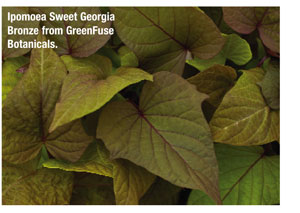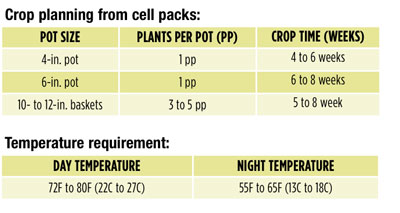4/27/2011
A Sweet-Growing Vine
Randy Uhl
 Ipomoea batatas
Ipomoea batatas or sweet potato vine is an ancient root crop native to tropical America. The varieties grown as ornamental annuals in current greenhouse production have been bred to have smaller (and not necessarily palatable) tubers compared to food crop varieties. Like its close relative morning glory, these vines, when mature, will flower early in the morning and will remain open for only a few hours. The small, lavender to blush white blooms often go unnoticed beneath the dense foliage canopy.
The large assortment of colors and leaf shapes available today can be credited to selections made from a multitude of crosses using both common and rare varieties from across the globe. But what makes ipomoea a significant crop in today’s ornamentals market is its ability to put on an impressive display as a landscape groundcover in both full sun and partial shade, with only minimal care once established.
The newer varieties of ipomoea have also been selected for a more compact, freely branching and uniform growth habit. Because of these characteristics, today’s ipomoea can be used successfully in mixed hanging baskets or patio pots, as they are less likely to overtake or smother their companion plants.
Protect ipomoea from temperatures below 45F (7C) since their roots and leaves are sensitive to low temperatures. Warm temperatures coupled with high light are optimal growing conditions for ipomoea. These vines are grown as annuals in most regions, being hardy in only USDA Zones 9 to 11.
 Media and pH requirements:
Media and pH requirements: Use sterile soil media with a pH range of 5.5 to 6.3. Keep evenly moist and avoid stressing plants. Stress can include overly dry or constantly wet soil conditions. Insufficient moisture will slow plant development and reduce leaf size. In established plants, especially in containers, as leaf area increases plants will dry out quickly and the leaf margins may brown from extreme desiccation.
Fertilizer requirements: Apply 100 to 200 ppm N constant feed using a balanced fertilizer. An initial indication of plants being underfed will be a faded color tone on the leaves.
Pinching requirement: Not required for 4- to 6-in. containers. To finish larger plants, ipomoea vines may benefit from a single pinch three to four weeks after transplant into finished containers.
Growth regulators: None should be required for regular production. A high light level combined with a reduced finishing temperature should make growth regulators unnecessary. Ipomoea will grow very rapidly at night temperatures above 70F (21C) and day temperatures above 85F (29C).
If a crop requires a PGR treatment, the best application method would be a PGR drench at reduced rates when plants reach 80% of desired growth.
Disease and insect pests: Aphids and white fly will be the problem insects during spring production. Regularly scout and use a preventative spray program for best control.
Root rot can occur if soil is constantly wet. Allow the soil to dry slightly between irrigations and apply a preventative fungicide.
Oedema can appear on ipomoea foliage, similar to that seen in ivy geraniums, when high humidity and wet soil conditions result in a high osmotic pressure within leaf cells, causing them to rupture. Oedema can be minimized by the use of venting to reduce humidity early in the day and to maintain a consistent temperature. Proper air movement around plants (horizontal air flow) will also help control this problem.
GT
Randy Uhl is the technical sales support/program manager for GreenFuse Botanicals and the Henry F Michell Co. You can reach him at ruhl@michells.com.